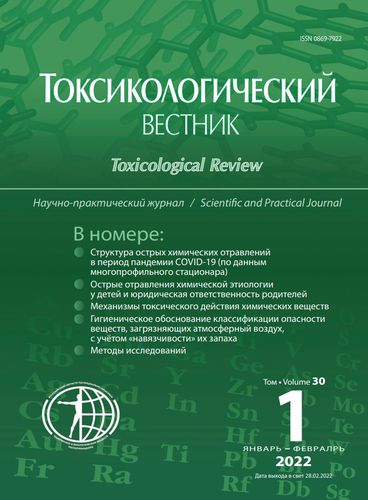Hygienic substantiation of the hazard classification of substances polluting the atmospheric air, taking into account the «offensiveness» of their odour
- Авторлар: Budarina O.V.1, Pinigin M.A.1, Shipulina Z.V.1, Andryushin I.B.1
-
Мекемелер:
- Federal State Budgetary Institution “Centre for Strategic Planning and Management of Biomedical Health Risks” of the Federal Medical Biological Agency
- Шығарылым: № 1 (2022)
- Беттер: 29-37
- Бөлім: Original articles
- ##submission.datePublished##: 17.02.2022
- URL: https://clinpractice.ru/0869-7922/article/view/641401
- DOI: https://doi.org/10.47470/0869-7922-2022-30-1-29-37
- ID: 641401
Дәйексөз келтіру
Толық мәтін
Аннотация
Introduction. Expansion of approaches to assessing the odour of substances polluting the atmospheric air, with the introduction of odorimetry (measuring the strength, intensity of odour) into practice indicates that the existing classification of the olfactory hazard of odorous components according to the “undefined” odour needs to be updated.
Materials and methods. Experimental studies with the definition of a quantitative expression of the dependence of the likelihood of odour detection of different strengths on the concentration were carried out using the example of 13 mixtures of volatile organic substances on a dynamic olfactometer. The volume of olfacto-odorimetric studies was over 4600 measurements. Statistical data analysis was performed using the Probit Analysis computer program (v.4.0).
Results. Based on the studies carried out, it was found that the lower the ratio of the concentration causing a 5% probability of detection of odour with a strength of 3 points (threshold of “offensiveness”, Limoff.) to the concentration causing a 50% probability of “undefined” odour (detection threshold or the threshold for an “indeterminate” odour, Limindef.), the more dangerous the substance is in relation to the development of an “offensive” odour. A new classification of the hazard of substances is proposed, taking into account the “offensiveness” of their odour: extremely offensive (Limoff./Limindef. ≤1.5), offensive (Limoff./Limindef. ≤3), moderately offensive (Limoff./Limindef. ≤6), slightly offensive (Limoff./Limindef. > 6).
Limitations. This study is not without certain limitations, among which the main ones are the use of a relatively new method that requires additional testing; a relatively small number of study participants; methods for presenting odor stimuli and registering them.
Conclusion. The ability of odorous substances to cause a feeling of “offensiveness” (“annoyance potential”), and, accordingly, their hazard class depends on the characteristics of the spectra of graph dependences of the probability of different strengths odour on the concentration on the probabilistic grid and the ratio of the parameters of the resulting dependencies.
Негізгі сөздер
Авторлар туралы
Olga Budarina
Federal State Budgetary Institution “Centre for Strategic Planning and Management of Biomedical Health Risks” of the Federal Medical Biological Agency
Хат алмасуға жауапты Автор.
Email: obudarina@cspmz.ru
ORCID iD: 0000-0003-4319-7192
Доктор медицинских наук, ведущий научный сотрудник отдела гигиены ФГБУ “ЦСП” ФМБА России, г. Москва.
e-mail: OBudarina@cspmz.ru
РесейMigmar Pinigin
Federal State Budgetary Institution “Centre for Strategic Planning and Management of Biomedical Health Risks” of the Federal Medical Biological Agency
Email: mpinigin@cspmz.ru
Доктор медицинских наук, профессор, ведущий научный сотрудник отдела гигиены ФГБУ “ЦСП” ФМБА России, г. Москва.
e-mail: MPinigin@cspmz.ru
РесейZinaida Shipulina
Federal State Budgetary Institution “Centre for Strategic Planning and Management of Biomedical Health Risks” of the Federal Medical Biological Agency
Email: zsipulina@cspmz.ru
ORCID iD: 0000-0001-8409-6713
Научный сотрудник отдела гигиены ФГБУ “ЦСП” ФМБА России, г. Москва.
e-mail: ZSipulina@cspmz.ru
РесейI. Andryushin
Federal State Budgetary Institution “Centre for Strategic Planning and Management of Biomedical Health Risks” of the Federal Medical Biological Agency
Email: iandryushin@cspmz.ru
ORCID iD: 0000-0002-5834-678X
Engineer of Hygiene Department of the Federal State Budgetary Institution “Centre for Strategic Planning and Management of Biomedical Health Risks” of the Federal Medical Biological Agency, 119121, Moscow, Russian Federation.
e-mail: IAndryushin@cspmz.ru
РесейӘдебиет тізімі
- Ryazanov V.A. Sanitary protection of atmospheric air[Sanitarnaya okhrana atmosfernogo vozdukha]. Moscow; 1954: 268 (in Russian)
- Tepikina L.A. Collection of scientific papers. Hygienic aspects of environmental protection [Sbornik nauchnyh trudov. Gigienicheskie aspekty ohrany okruzhayushchej sredy]. Moscow: IOKG im. A.N. Sysina; 1974; (2): 45-7. (in Russian)
- Andreeshcheva N.G., Pinigin M.A. Substantiation of the maximum single MPC of atmospheric pollutants by their probabilistic odor thresholds, hazard classes and safety factors. Collection of scientific papers. Hygienic aspects of environmental protection [Sbornik nauchnyh trudov. Gigienicheskie aspekty ohrany okruzhayushchej sredy]. Moscow: IOKG im. A.N. Sysina. 1978; (6): 75-6. (in Russian)
- Pinigin M.A. Hygienic regulation and control of atmospheric pollution in Russia taking into account odor, as well as ways of harmonization in this area. International Conference “Topical issues of odor assessment and regulation” [Mezhdunarodnaya konferenciya «Aktual’nye voprosy ocenki i regulirovaniya zapaha»]. Moscow; 2006: 30-40. (in Russian)
- Temporary guidelines for the substantiation of maximum permissible concentrations (MPC) of pollutants in the atmospheric air of populated areas № 4681-88. [Vremennye metodicheskie ukazaniya po obosnovaniyu predelno dopustimykh kontsentratsiy zagryaznyushchikh veshchestv v atmosfernom vozdukhe naselennykh mest № 4681-88]. Moscow: MZ SSSR; 1989. (in Russian)
- Assessment of community response to odorous emissions. R&D Technical report P4-095/TR, undertaken for the Environment Agency by OdourNet UK Ltd, – 2002. Avaible at: https://www.gov.uk/government/uploads/system/uploads/ attachment_data/file/290405/sp4-095-tr-e-e.pdf (accessed 5 February 2021).
- Horizontal Guidance for Odour. Part 1 – Regulation and Permitting - Part 2: Assessment and Control. Draft. IPPC H4. Avaible at: https://www.sinia.cl/1292/articles-55482_UKEPA_2002_IPPC _H4.pdf (accessed 15 February 2021).
- Brancher M., David Griffiths K., Franco D., De Melo Lisboa H. A review of odour impact criteria in selected countries around the world. Chemosphere. 2016; 168(11): 1532-70.
- Budarina O.V., Pinigin M.A., Fedotova L.A., Sabirova Z.F., Potapchenko T.D. Modern methodological approaches to the experimental substantiation of the permissible content of substances with odor in the atmospheric air. Toksikologicheskij vestnik. 2017; (4): 34-9. (in Russian)
- Air quality guidelines for Europe. Second edition. Moscow; 2004. Avaible at: https://www.euro.who.int/ru/publications/abstracts/air-quality-guidelines-for-europe (in Russian) (accessed 24 January 2021).
- Evropejskij standart «CEN (2003). Air quality – Determination of odour concentration by dinamic olfactometry. EN 13725:2003», European committee for standardisation. Avaible at: https://s.siteapi.org/b1502e229a03ef7.ru/docs/djvkf84k1t4owwco0cwocco4oco8ww (accessed 15 February 2021).
Қосымша файлдар







